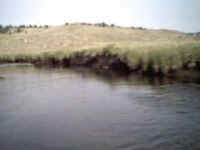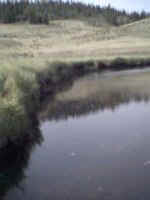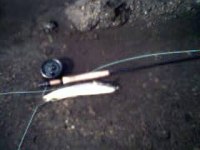The Big One That Didn't Get Away (Finally)
by Terry Stahl(Editor's note - this story takes place in Colorado, but it could be anywhere in the West)
As I headed out the door to a favorite fishing spot, I could hear the thunder rumbling, off in the not-too-distant mountains. Even though it was 3 p.m. on a mid July day, darkness was closing in as if the sun were saying goodbye to another day in five minutes. As I looked toward the continental divide 15 miles away, I could see the rain falling. I just hoped it would stay in the mountains and not come down to the valley, which was where I was headed.
As I pulled to the side of the road next to Tarryall Creek six miles above the reservoir, there were a few continuing rumbles of thunder off to the west. As I rigged my 9’ 5wt St. Croix fly rod with my special caddis imitation, I wondered if the lack of bright sunshine would bring out the big ones from their daily hiding places. I also thought to myself, at least I wasn’t getting any static electricity between my thumb and graphite rod like I did the day before, but that is another story.
I carefully opened the barbed wire gate and locked it behind me. I slowly approached the crystal clear meadow stream on my knees and cast to the riffle below me. Today in this usually productive pool, there seemed to be nothing interested in my offering. I stood up and headed upstream to the next undercut bank.
After fishing this stream for seven years, I have discovered the fish are very finicky. If your fly is more than six inches from the bank, you probably won’t get a bite. I have proved this with friends, much to their amazement. I have them cast to a hole anywhere they want. Usually, there is no response. Next I tell them to cast no more than four inches from the bank. Usually, they get a strike even after they have cast to the hole already.
The next hole is a section of collapsed bank along the deep side of the stream. The stream is about 10 feet wide and is about two and half feet deep next to the far bank. With the wind blowing about 15 mph, I made a futile attempt to cast next to the partially sunken bank. The first cast went to the middle of the stream. My fly floated untouched. My second cast made the adjustment for the wind and landed two inches from the bank. Within the first six inches of floating, my fly disappeared and in its place came a loud gulp of air and a medium size circle. I tried to set the hook, but all I received for my effort was a pretty good false cast. I continued to cast a little further upstream from each previous cast until again my fly disappeared. Unfortunately, the same result occurred when I set the hook. Nothing.
Next, I had to cross the stream at a riffle that barely came to knee high. I walked up the grass bank to the sand bar that was now exposed as the spring runoff had receded. Across from me was a riffle about five feet long and one foot wide with a section of backwater between the overhanging bank and the riffle. Five or six casts to various sections of the riffle produced nothing. The first two casts to the backwater also produced nothing. The third cast went into the water just behind the overhanging portion of the bank. Instantly, my fly disappeared into a very small circle. I set the hook and finally had something at the end of my line. The fish fought well, but was rapidly at my feet. I quickly released the slender 13” inch brown with an oversized head.

I moved on to a long pool with a medium current flowing next to the bank. The pool was about 30 feet long with a three-foot high bank. I cast to the bank at the tail of the pool and was rewarded with a nice 9” brown trout. It was quickly released to be caught another day. One more 11” fish was caught and released in this pool. The wind was getting a little stronger now with occasional gusts that made it very difficult to cast. Luckily, the stream meanders in the meadow so, finding a hole downwind or crosswind just means walking about 10 yards more.
The next hole was a long slow moving challenge. The surface looks like a glass table top with no noticeable current. The bank is about three feet above the water and the depth of the water is almost five feet. My first cast was about five inches from the bank half way up into the hole. Almost immediately, my fly disappeared. I set the hook and was into another good fish. This fish took a little longer to land and release. It was a hefty 13” brown with bright pink spots. I caught and released one more 12” fish further up the hole.

Above the glass-like water is another section where the bank has fallen away and is half in and half out of the water. Two feet above the partially submerged bank is an undercut bank with grass growing down toward the water. There is a section about 15’ long with the grass growing down, but there is about 3 inches of room between the end of the grass and the water. My first cast was about a foot away from the grass. I picked up the fly just after it passed the end of the partially submerged bank. My second cast was two inches from the grass. As it drifted downstream to about three feet above the bank, my fly disappeared. I set the hook and found a 9” brown on the end of my line. It was brought in quickly and released. Three more casts in the same area produced nothing. I was trying to get my fly under the grass next to the bank, but the wind was not cooperating. Finally, on the fourth cast after the last fish I put the fly where I was trying to get it. It drifted down the 15 feet of undercut bank and nothing. I was just about to lift the fly from the water as it cleared the undercut bank, but decided to let it drift past the end of the partially submerged bank, when there was a very large splash. I was very surprised that a fish hit the fly after so many drifts going untouched, but I instinctively set the hook. Well, the next thing I knew my rod was bending in half. This fish went deep immediately. To me on this stream, that is a sign of big fish. I applied pressure to my delicate 4lb tippet, trying to move the fish. I was unable to do so for about 15 seconds. Finally, my pressure forced the fish to move from the bottom. And move it did! The fish came completely out of the water and I could not believe my eyes at the size of this fish. I did notice that is was a brown during its aerial antics. The fish and I went up and down the pool for about five minutes. Finally, I got its head above the water and started to back up on the sandy bank. The fish came toward the bank, but the sand came up to steeply from the water for me to drag the fish to the bank. I moved upstream about four feet to where the sand was replaced by rocks. There was no sandy lip here. The next pass, I again got the big fish’s head out of the water and proceeded to back away from the water. This time the fish came on the bank about two feet and it began to flop around. I quickly dropped my rod and tried to grab the fish. After missing three times, I finally pinned the fish to the ground. By now the fish was half in and out of the water. I tried two times to take the hook out of the fish’s mouth, but it was imbedded in the upper jaw very securely. I grabbed by pliers on my vest and removed the hook. Still not believing its size, I put both hands together, thumb to finger tip and spread my hands. (I have a nine inch spread from little finger to thumb.) Even with BOTH hands spread, by hands did not cover this monstrous brown. I estimated the fish was two or three inches longer than my span of 18 inches. As quickly as I could, I picked up the fish and put it back into the water. I had to hold its tail and move it up and back, to force water through its gills. After two minutes of this, I released the fish. It stayed in the shallow water inches from my foot for another two minutes before heading back to its hiding place. That was the biggest trout I have ever caught. And to do it in a stream that is usually no more than 10 feet wide was a real surprise

I fished one more hole and caught another fat 12” brown that was released. I decided I had my gift from the fishing gods and called it a day, but I will always remember the fight and the release of that fish. I will try to catch him again when I fish this stretch of water. This has always been my favorite stretch of water and it just became my most memorable one, too. It must be true, dark cloudy days do bring out the bigger fish!! (I never did get rained on, and it wouldn’t have mattered if I had, after a catch like that.)
#######
Terry Stahl lives in Colorado Springs and has been fishing for 35 years. He submitted this article and photos to the Colorado Fishing Network. If you have an article or photos you'd like to share, email us.


